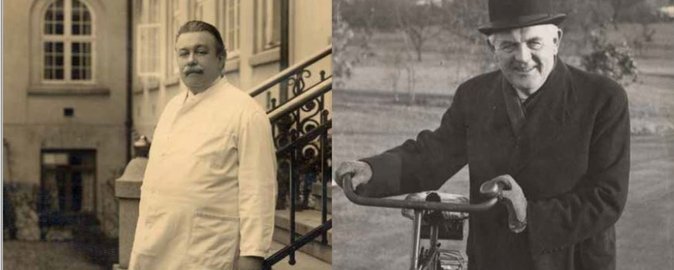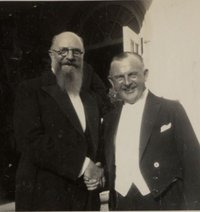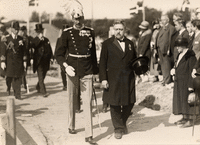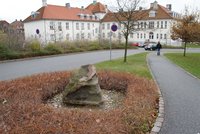- Education
-
Research
Current research
Talent
-
Collaboration
Businesses
Government agencies and institutions
Alumni
-
About AU
Organisation
Job at AU
One took the initiative, and the other made it all happen. Meet the two driving forces behind the founding of Aarhus University: physician Victor Albeck and High Court Attorney Carl Holst-Knudsen. These two passionate individuals have left a strong impression on campus and their spirits live on in the Victor Albeck Award and the Rigmor and Carl Holst-Knudsen Award for Scientific Research, which supports both early-career and established researchers.
2021.05.20 |

Obstetrician Victor Albeck (left) and High Court Attorney Carl Holst-Knudsen (right) each played a significant part in the earliest history of Aarhus University.

Carl Holst-Knudsen (right) met then Prime Minister Thorvald Stauning several times.

Victor Albeck (right) next to King Christian X at the groundbreaking for Aarhus University on 30 August 1932.

Victor Albeck is buried in the University Park, close to the building that bears his name: the Victor Albeck Building.
There was only one university in Denmark for more than 400 years. There was no scientific environment in Aarhus and there was no way to take an academic degree in Jutland. Two visionary academics in Aarhus thought this was wrong and they determined to rectify the situation. In the 1920s, they both began their work to secure easier access to higher education in Jutland and to elevate the academic level in Denmark as a whole. Their efforts and tenacity bore fruit, and they pioneered what we today know as Aarhus University.
Aarhus University's finest awards bear their names: Victor Albeck and Carl Holst-Knudsen.
But who were they, and how did they leave their mark? We'll begin with Victor Albeck.
If you are in the University Park, head down to the southern section of the park and find the place where Bartholins Allé and Wilhelm Meyers Allé intersect next to the Lakeside Lecture Theatres. You will find a large, dark-grey rock surrounded by bushes. It is a gravestone, the only one in the park, and the name on the stone is Victor Albeck (1869-1933).
Victor Albeck was born in Copenhagen on 9 January 1869. He graduated with a Master’s degree in medicine in 1894 and subsequently trained as an obstetrician and gynaecologist. In 1910, he was appointed as the first senior physician of the Jutland Maternity Home, the white palatial-looking building in Vennelystparken.
Victor Albeck is said to have been a friendly man. He was a good obstetrician, but could never remember the faces of the women he helped in the delivery room, so to be on the safe side he said hello to all the women he met with a pram.
Victor Albeck was one of the driving forces behind the establishment of the Jutland Medical Society, of which he became chair in 1920. At the society, doctors gathered to listen to scientific lectures, observe demonstrations and hold debates, and it became a sort of health science "faculty" without students. In his role as chair, Victor Albeck took a central position in work to establish a university in Aarhus.
The previous Copenhagener had become a full-blooded Aarhusianer and he made great efforts to advance the scientific environments in the city. Together with representatives from the State and University Library, and the city’s museums, upper secondary schools and hospitals, he established a number of scientifically oriented history and natural science associations, created reading groups and established natural science collections. All this was with a view to establishing a university in Aarhus. Victor Albeck even held meetings for university advocates at his own house.
Professor Karl Anker Jørgensen is on the board of the Aarhus University Research Foundation and is chair for the foundation's award committee. He helped found the newly established Viktor Albeck Award, which will be awarded for the first time on 26 May this year.
“Victor Albeck’s tireless efforts were critical to the new university ending up in Aarhus. With this award, we salute the pioneering spirit, determination and persistence of Victor Albeck and the award winners. Supporting up-and-coming talents at Aarhus University accords very nicely with the spirit of Victor Albeck," says Karl Anker Jørgensen about the award, which is given to talented early-career researchers affiliated with Aarhus University.
In 1926, Victor Albeck took over as chair of the Aarhus University and City Liaison Committee, and on 11 September 1928, Aarhus University saw its tentative beginnings in rented premises at the technical college on Nørre Allé. Victor Albeck became chairman of University Teaching in Jutland, as Aarhus University was then called. When the bricks were laid for Aarhus University’s first building in 1932, Victor Albeck received the gold Medal of Merit from King Christian X. Victor Albeck died the following year and was laid to rest next to the building that once housed the Jutland Maternity Ward and that since 2000 has borne his name: the Victor Albeck Building.
After Victor Albeck’s death, Carl Holst-Knudsen took over the chairmanship of the Aarhus University and City Liaison Committee and University Teaching in Jutland. He was a high court attorney and conservative member of the city council. Carl Holst-Knudsen had worked with Victor Albeck on both boards and was a talented strategist and fundraiser, who managed to raise private funding for construction of the university’s buildings. He always had a ready argument when the time came to shake the pockets of successive ministers of education.
It is said that Carl Holst-Knudsen was a man with great personal authority. The Danish prime minister at the time, Thorvald Stauning, was on the receiving end of that authority during the inauguration of the university’s first building; Carl Holst-Knudsen told Thorvald Stauning to stop drinking. And the Prime Minister obeyed.
Carl Holst-Knudsen was married to Rigmor Holst-Knudsen, and the couple donated an 18-carat-gold rector’s chain of office to the university in 1935. The chain of office is still worn by the rector on special occasions, for example at the university’s highly ceremonial annual celebration in September and at the presentation of the Rigmor and Carl Holst-Knudsen Award for Scientific Research every year in May. This award was established by a number of foundations and companies on 28 May 1956 on Carl Holst-Knudsen’s 70th birthday, and has since been presented to a large number of prominent researchers, including Associate Professor Johannes Sløk, Professor Poul Nissen, Professor Dorthe Berntsen, Professor Jens Christian Djuurhus and Professor Lene Hau.
Carl Holst-Knudsen was one of the most prominent figures at the newly established Aarhus University, and according to Rector Brian Bech Nielsen, it was therefore natural that Aarhus University name a scientific award after him.
"Together with local politicians, Carl Holst-Knudsen secured broad popular support for the university from residents and businesses. The dream of establishing a new university was mainly realised because he made it clear that the citizens of Jutland wanted a university. Carl Holst-Knudsen understood that universities ultimately belong to society and its citizens," says Brian Bech Nielsen.
Carl Holst-Knudsen died in 1956, shortly after his 70th birthday. A path in University Park was named after him. The path is close to the halls of residence that were built at his initiative.
From the first 64 students in rented rooms on Nørre Allé in the early 1920s to the 38,000 students now spread across AU's world-famous campus and across Denmark, none of this would have been possible without Victor Albeck and Carl Holst-Knudsen. Aarhus University’s obituary of Carl Holst-Knudsen describes the natural partnership between the two: Victor Albeck is described as the inventive type, while Carl Holst-Knudsen was the pragmatist. To quote: "In the history of Aarhus University, these two men entered the stage at exactly the right time.”